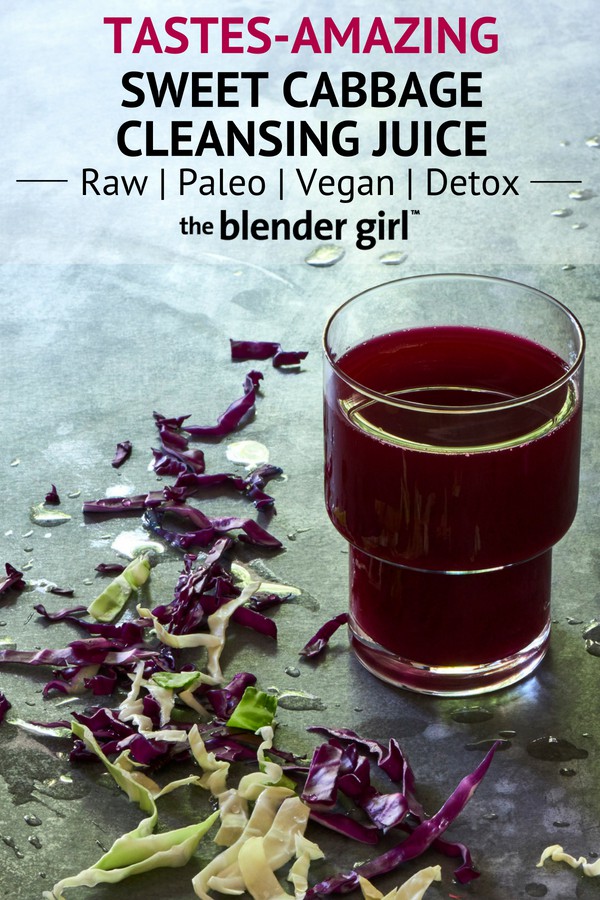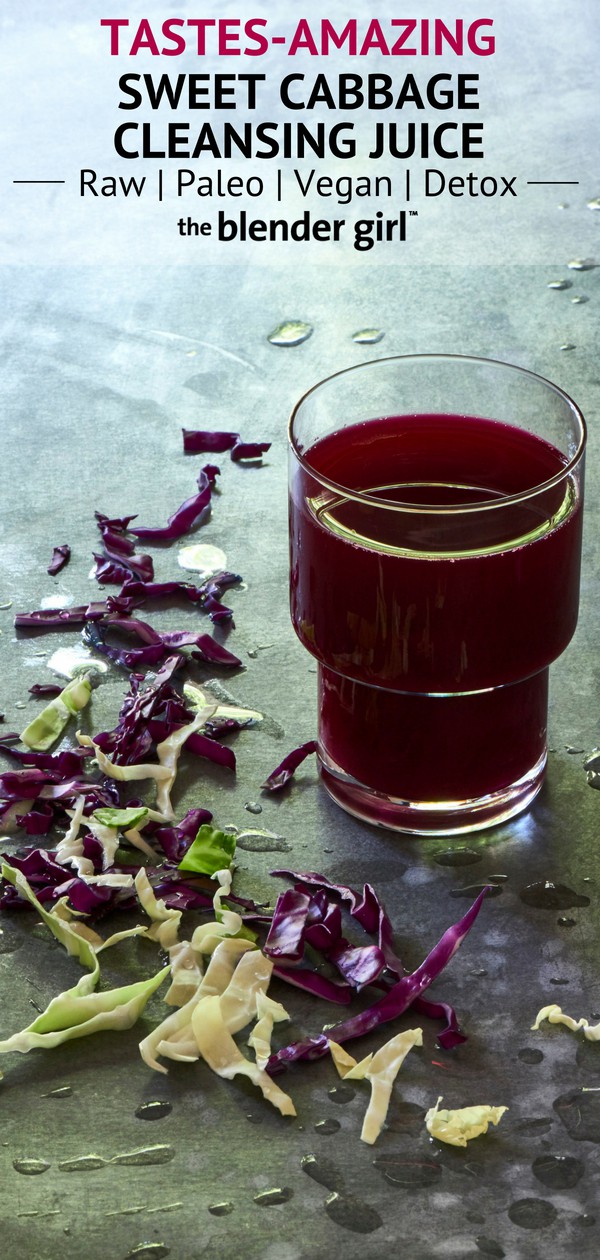Apple, Ginger, Beet, Cabbage Juice
If you think cabbage juice can’t taste amazing, this apple, ginger, beet, cabbage juice recipe from Robyn Law may change you mind! Robyn mixes red and green cabbage with sweet beets, carrots, celery, apple, lemon, and ginger to create a yummy juice that will make your crazy for cabbage.
The health benefits of cabbage juice
Cabbage is absolutely loaded with goodness. I eat red, white, and savoy/Chinese cabbage regularly to reap the multitude of health benefits. Cabbage contains powerful antioxidant and anti-inflammatory properties. It’s wonderful for heart health, helping to reduce cholesterol by binding bile acids in the intestine. Toxins pass them out of our bodies in a bowel movement rather than emulsifying in our liver. The lactic acid in cabbage also acts as a potent colon cleanser.
Cabbage also contains fabulous phytonutrients that help protect the body from free radical damage, and the detox dynamo compound sulforaphane, which increases the production of antioxidant and detoxification enzymes, and stimulates the production of glutathione for liver cleansing.
Rich in iron and sulfur, cabbage is an excellent source of vitamin C, a good source of vitamin A, making it a great muscle builder and blood cleanser. It is also wonderful for skin and eye health.
Cabbage juice, in particular, is a magical elixir that helps to heal all kinds of ailments. The Romans and Greeks used to drink raw cabbage juice to relieve sore and infected eyes. It can also help reduce headaches, and respiratory complaints such as asthma and bronchitis. Really effective for treating fungus infections, cabbage juice is also a brilliant digestive aid, fostering the proliferation of healthy bacteria in the stomach, preventing stomach ulcers.
The health benefits of beet juice
With loads of betaine to flush the liver and bring down homocysteine levels, beets help reduce the risk of cardiovascular disease, aiding brain function, and stabilizing mood. Since beets optimize the red cells’ utilization of oxygen they’re very helpful to endurance athletes. Minerals in beets include calcium, potassium, iron, copper, and sodium. On the thermic side, beets are a “neutral” food, neither warming nor cooling, so they’re great for juicing all-year-round.
To juice raw beets, there’s no need to peel them. Just give your beets a scrub, roughly chop, and juice away.
Nothing beats a beet for clearing the body— maybe faster than you’re looking for. So if you’ve not juiced beets before, start with a little, a quarter to a third medium-sized root, going easy until your system gets accustomed to the effects. Overdo it and you may be paying the porcelain deity more frequent homage than you’d like.
If your urine gets a pinkish or reddish tinge, no need to be alarmed. That’s a sign that you’re “beeting” the toxins.
The health benefits of celery juice
Alkalizing, detoxifying, anti-inflammatory, and loaded with nutrients: essential amino acids, tryptophan, vitamins A, B complex, C, calcium, phosphorus, iron, magnesium, iodine and copper, celery is also effective against respiratory conditions like bronchitis and asthma, and helps lower blood pressure. The organic sodium and potassium in celery make this juice a great post-workout refresher that helps replace electrolytes. It’s also a natural laxative and diuretic, supporting bowel and kidney health. Celery is a cooling vegetable, and we work it into our juices to take advantage of the rich mineral content and natural calming and sedative properties. We like it just as much, though, for its great flavor.
The natural salts are more abundant in the leaves, so when juicing celery, push the entire stalk (leaves and all) through the machine. That will yield a tangier, more savory juice. Celery makes a nice addition to almost any mix, especially juices made with leafy greens and other vegetables. As it sits, celery juice tends to get more assertive flavor-wise, so it’s best enjoyed right after it’s made. If you’re not using immediately, chill it, sealed up, but for no more than a few hours.
The health benefits of apple juice
Tasty, able to break down toxins, lower cholesterol, and enhance digestion, this fruit is a popular, versatile, and cost-effective go-to for juices. With phytonutrients, powerful antioxidants like quercetin, vitamin A (in the peel), vitamin C, and significant potassium, apple is a prime detox food that’s available year ‘round. As an aid to cleansing, apples’ high pectin content provides a great bowel regulator, able to slow the colon down or speed it up, as the body needs.
Apple is a cooling food, and we include it in juices to balance the bitterness of leafy greens and other vegetables. The sweet tang of apple blends with almost all fruits and vegetables; our preferred variety is Granny Smith, which has a tarter flavor and lower sugar content than common reds like Fuji, Delicious, and Honeycrisp. That said, this fruit is versatile, and our recipes work with any apple you have on hand.
We recommend coring apples before juicing, as the jury is still out as to whether the bit of cyanide occurring naturally in the seeds is detrimental to health.
The health benefits of carrot juice
Carrots contain loads of life-extending carotenes and minerals. This vegetable helps lower cholesterol, too, and alleviates skin conditions like psoriasis and eczema, all while enhancing the respiratory system’s resistance to infection. A great source of vitamin A, carrots also contain the magical antioxidant glutathione, which protects against free radical damage, and B vitamins, potassium, magnesium, and phosphorus.
Carrots fuel the production of white blood cells and enhance their performance, and are a great immune booster. These brilliant orange roots also deliver powerful anti-inflammatory agents, helping to relieve the symptoms of rheumatism and arthritis.
Carrot is a warming and strengthening vegetable perfect for cleansing. Cut off the greens (the jury is still out as to whether they are toxic or beneficial), but don’t peel the roots—much of carrots’ nutrients lie in the skin or just beneath. Just scrub, roughly chop (if using certain masticating juicers) and push through your juicer.
The earthy sweet flavor of the juice, much richer than that of carrot itself, combines well with apple, pineapple, beets, tomato, ginger, and cinnamon, so this one works well in both sweet and savory juices.
The health benefits of lemon juice
Lemon is the queen in the realm of cleansing. This highly alkalizing fruit is a potent detoxifier and natural antibiotic that improves liver function, relieves constipation, helps dissolve kidney and gall stones and kills certain intestinal parasites. The high levels of vitamin C helps boost immunity and alleviate symptoms of osteoarthritis and rheumatoid arthritis, as well as fight the development and progression of atherosclerosis and diabetic heart disease.
Lemons also provide ample calcium and magnesium for strong bones and teeth, along with unique compounds that have powerful antioxidant and anti-cancer properties. The flavonoids in limes have even been shown to halt abnormal cell division.
While lemons are cooling, this superstar can be balanced with warming foods like cayenne and fennel. I use lemons in lots of juice blends to lift the earthy and pungent quality of leafy greens and vegetables, add zip and tang, and balance the acidifying impacts of high-sugar fruits.
Remove the rind before juicing, as in substantial quantities it’s slightly toxic.
The health benefits of ginger juice
Ginger is a brilliant health-promoting juice booster gives beautiful back-end kick to blends of all kinds. In one serving of juice, as little as a half-inch slice of washed, unpeeled root packs a powerful punch. We rely on ginger as a warming agent, to counteract the cooling effects of fruits and vegetables, and to promote healthy sweating, beneficial to the cleansing process and fantastic for battling colds and flu.
This sensational herb-and-spice is an overall anti-inflammatory agent that stimulates the lymphatic system, provides cardiovascular and respiratory support, aids digestion and tones the intestinal tract, and relieves gas, bloating, nausea and gastrointestinal distress. It helps make blood platelets less sticky, and reduces risk factors for atherosclerosis. Ginger’s powerful antioxidants and anti-tumor agents can also protect against free radicals.
There’s no need to peel ginger before juicing. Much of the nutrients are in the skin or just beneath. Scrub the root, lop off a piece, and juice away. In our experience, people either love ginger in a juice, or hate it. Starting slow’s a good way to go if you’re unsure which camp you’re in.
Other Green Juice Recipes For You
Green-Aid – The Best Green Juice
Immune-Boosting Green Juice
Allergies-Be-Gone Green Juice
Alkaline Low-Sugar Green Juice
Get Healthy With a 3-Day Juice Cleanse
1. DOWNLOAD the FREE 5-Day Energy Boost.
2. START the 3-Day Juice Cleanse.
3. JOIN our Cleanse Facebook group to get support.
Let me know what you think of this recipe in the comments!
Your feedback is important to me, and it helps me decide which recipes to post next for you.











Comments 3
I love the Rhapsody in red midday cleanse. It was very good tasting and very cleansing???
Great! Glad you enjoyed this. It IS delicious and is a fabulous detox aid too 🙂
what is 1/2 red bee, scrubbed?